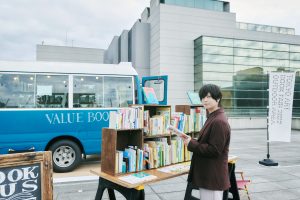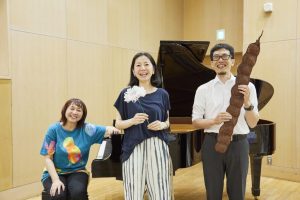Art Brut is a term proposed by the French artist Jean Dubuffet in the 20th century. Today, it broadly refers to art pieces that focus on unique ideas and expressions of individuals who have not received specialized artistic education. The Tokyo Shibuya Koen-dori Gallery, along with the Tokyo Metropolitan Government annually creates exhibitions introducing noteworthy Japanese Art Brut artists who have gained attention in recent years. In the 2023 edition, the exhibition titled “Dear Stories: Tales and Talks” tours Tokyo, beginning at the Sumida Riverside Hall Gallery (9/24-10/4), exhibiting at its base at the Tokyo Shibuya Koen-dori Gallery, and concluding at the TAMASHIN RISURU Hall in Tachikawa City (2024/1/24-2/7).
This year’s theme revolves around “tales,” featuring seven artists. Alongside the “tales” each artist has woven from their personal experiences and thoughts into their creations, the exhibition carries a layered significance: the unfolding “narratives” one can discover by viewing and touching the artworks, and the act of “narrating” these experiences adds layers of meaning, weaving together a collection of shared tales.
The act of expression, the act of viewing, the freedom from constraints—what Win Morisaki gained from the Art Brut 2023 Touring Exhibition ‘Dear Stories’
Event Reports
No.038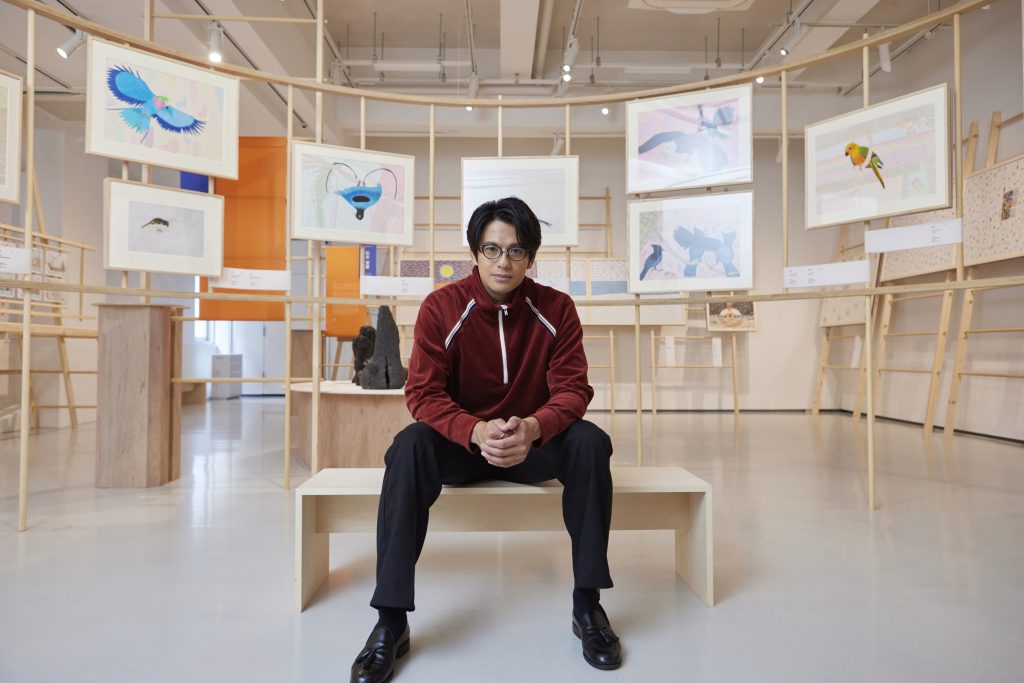
At the Tokyo Shibuya Koen-dori Gallery, “Art Brut 2023 Touring Exhibition ‘Dear Stories: Tales and Talks’” is being held from October 21 to December 24, 2023. Serving as the audio guide navigator for this exhibition is the actor and artist actively making a name of himself, Win Morisaki. Mr. Morisaki, making his first attempt at being an audio guide for an art exhibition, promptly visited the venue and engaged with the art pieces featured in the exhibition, guided by Kaoru Ouchi, this exhibition’s planner and a curator of the gallery.
What is Art Brut, the recently spotlighted art genre?
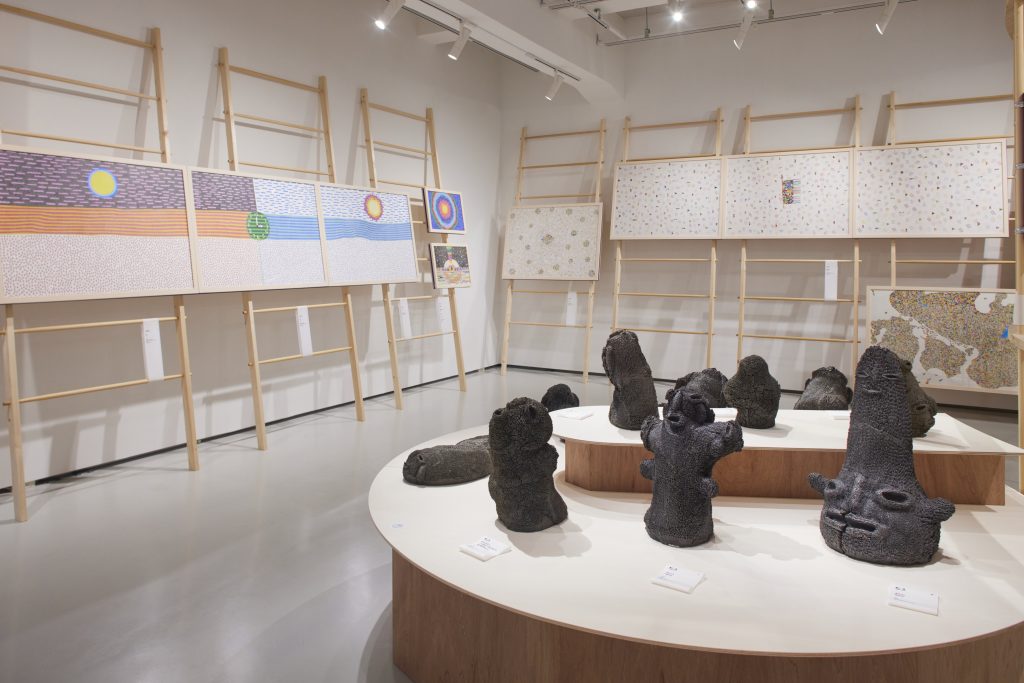
Exhibition venue: Tokyo Shibuya Koen-dori Gallery
Overwhelmed by the energy overflowing from the artworks
Serving as the navigator for the free audio guide available at the exhibition is Win Morisaki. In his gentle narration, he guides visitors through the “tales” and highlights embedded in the works of seven artists.
Mr. Morisaki, upon visiting the venue, first pauses at the artwork of Takeshi Tominaga, who creates automatons.
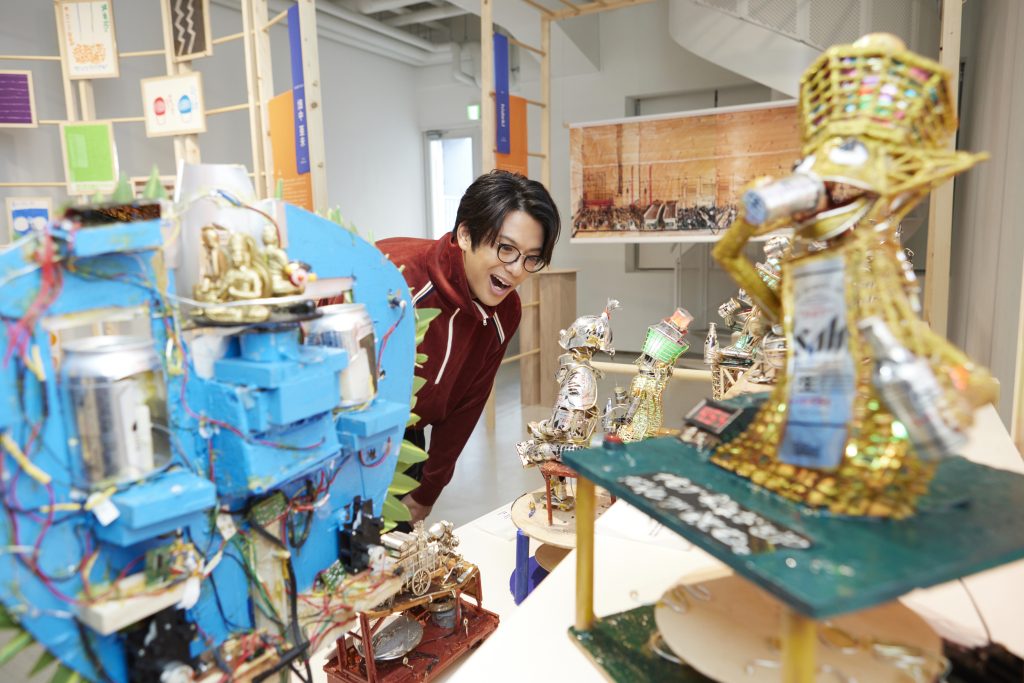
Takeshi Tominaga, currently in his 70s, has been living in the day laborer town of Kamagasaki in Osaka since his 60s. Through his daily habit of reading, he learned about automatons and began creating them on his own. His chosen material are empty beer cans. He cuts square pieces from aluminum cans, flattens them on a plane, and assembles everything freehand without the use of blueprints.
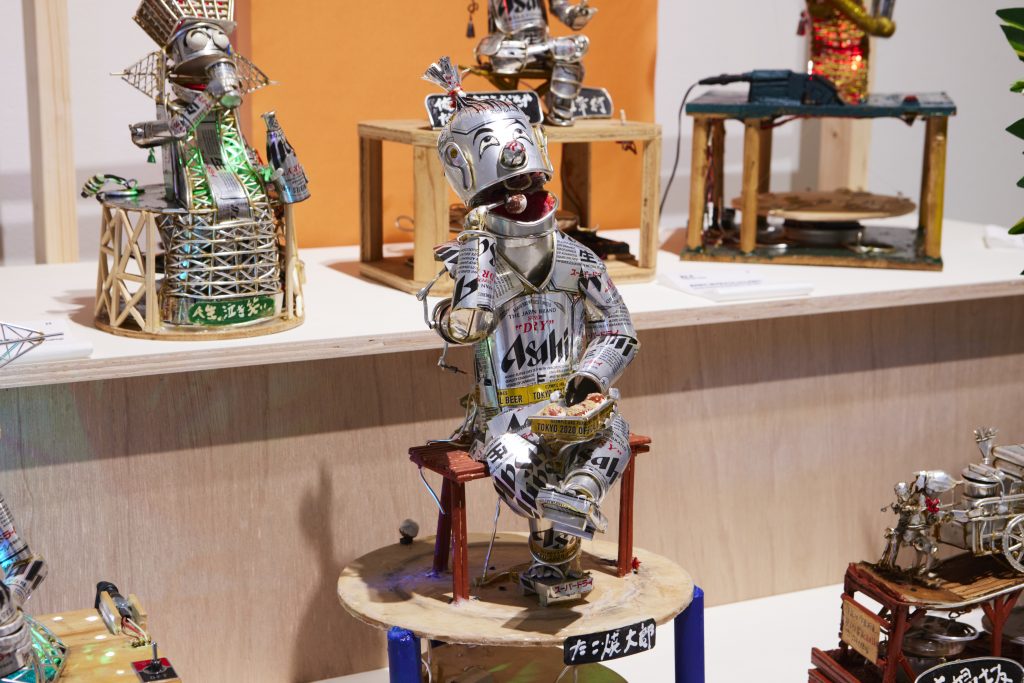
Squatting down, he is captivated by the work of hideki, the diorama artist.
hideki creates dioramas of fictional neighborhoods using scrap, glue, and modeling supplies. The work is titled as Kita-Sendai Station, it’s a fictional landscape as he has never visited the location. Half of the diorama, completed over nearly a decade within his home, is on display. The remaining half is disassembled, fixed to shelves in his home, with the addition of a painted cityscape on the background wall. It is like scrap and build as he constantly tweaks the diorama. Filled with overwhelming elements, it generates narratives not just from hideki’s endless tale but also from the stories evoked in viewers as they witness the constant dismantling and creation, a process he repeats without showcasing to anyone.
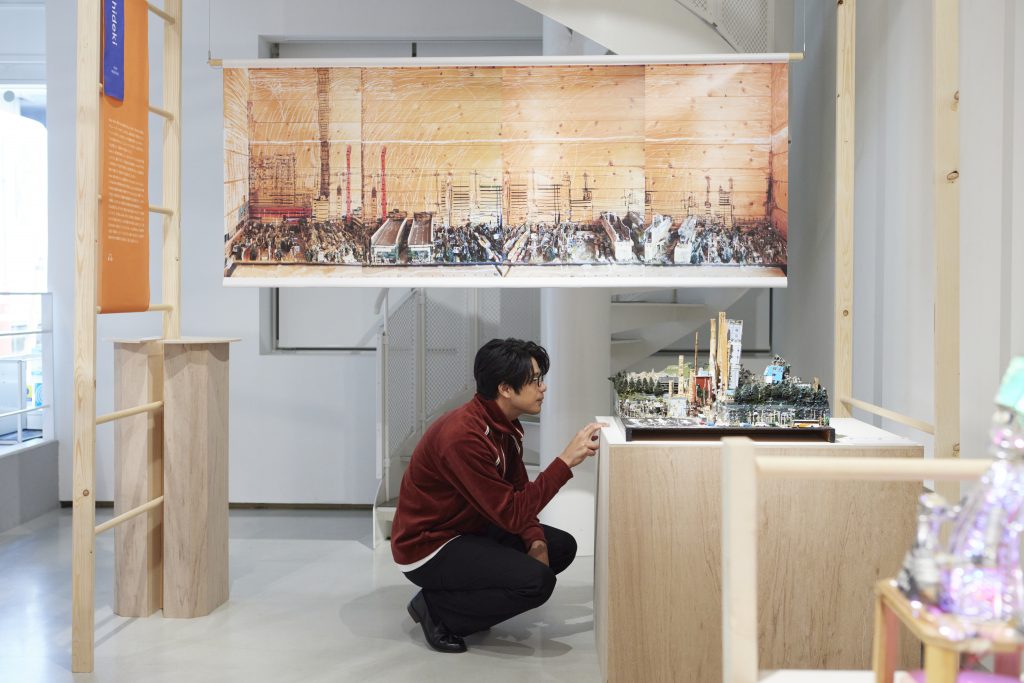
“An incredible number of traffic signals...” Mr. Morisaki carefully examines the intricate details.
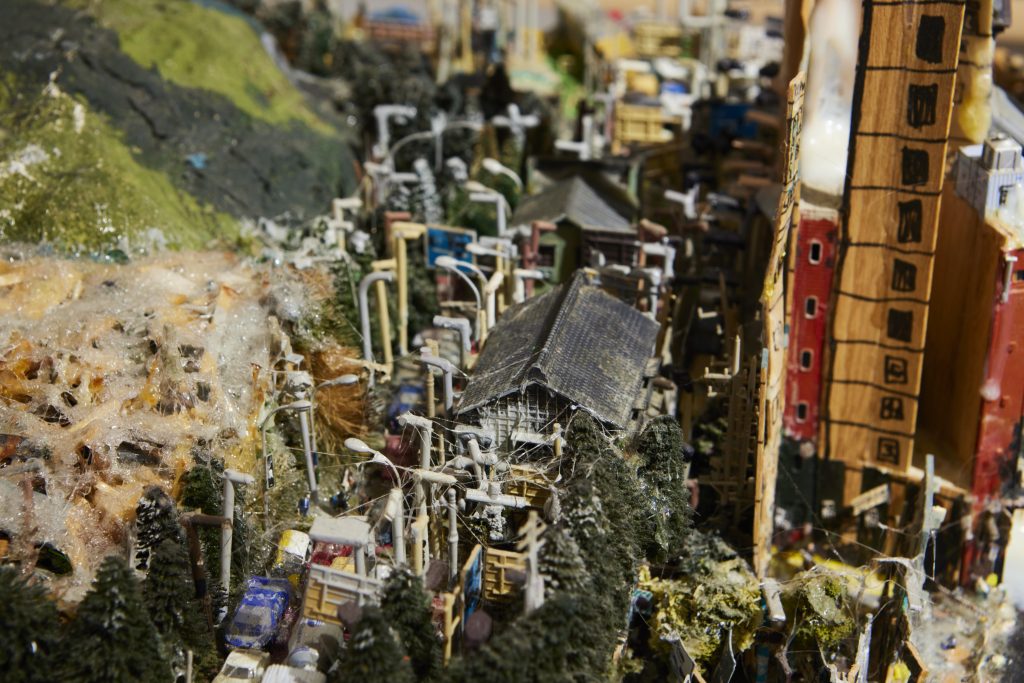
A diorama intricately crafted down to the smallest details.
At the corner featuring the large, colorful works on drawing paper by Tsugumi Hatanaka, Mr. Morisaki stands still. Tsugumi Hatanaka selects freely from memorable aspects of her society and daily life, using a unique depiction method, simple lines, and bold arrangements. Her depictions of familiar motifs evoke empathy.
Particularly catching Mr. Morisaki’s interest is Asobeach Ishikari’s Brown Ocean, among them.
“It reminds me of the final scene in The Fabelmans, said to be Director Spielberg’s autobiographical film. There’s a suggestion that the meaning of what you want to symbolize changes depending on the position of the horizon. This, too, places the horizon low. Perhaps she wanted to emphasize the vastness of the sky.”
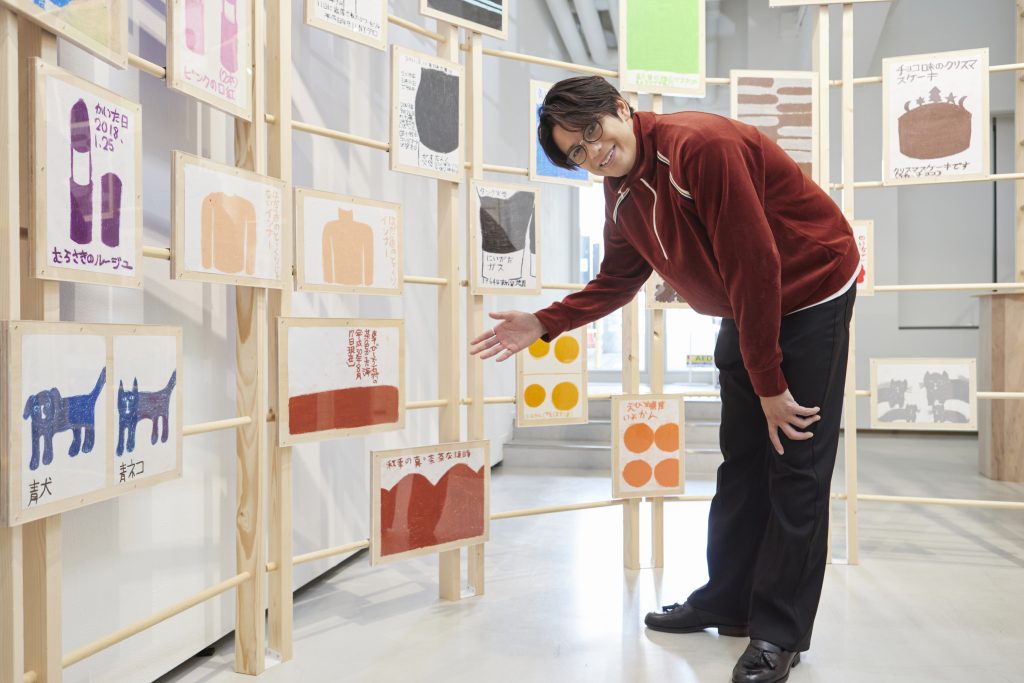
Next, we move on to the works crafted from clay by Kazumi Kamae.
Kazumi Kamae brings to life “Masato-san,” director of Atelier Yamanami to which she belongs. Beyond simple forms, her sculptures portray stories woven in her imagination, such as sharing lunch during a picnic or going out for ramen together. The textured small bumps covering the entire surface are a technique ingeniously employed to capture the essence of his hair and tie.
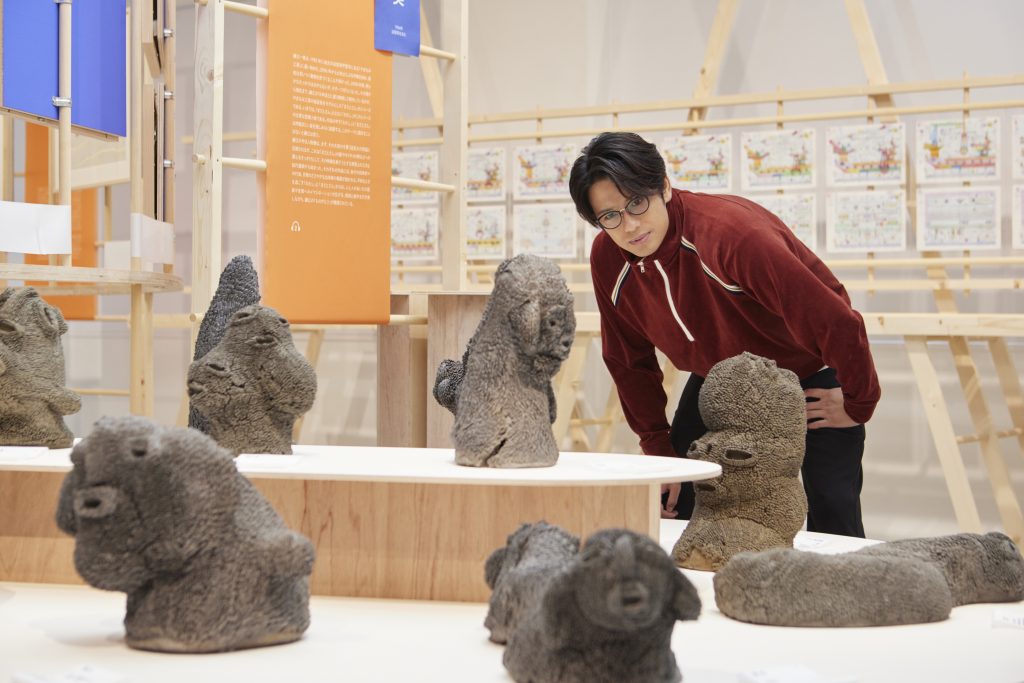
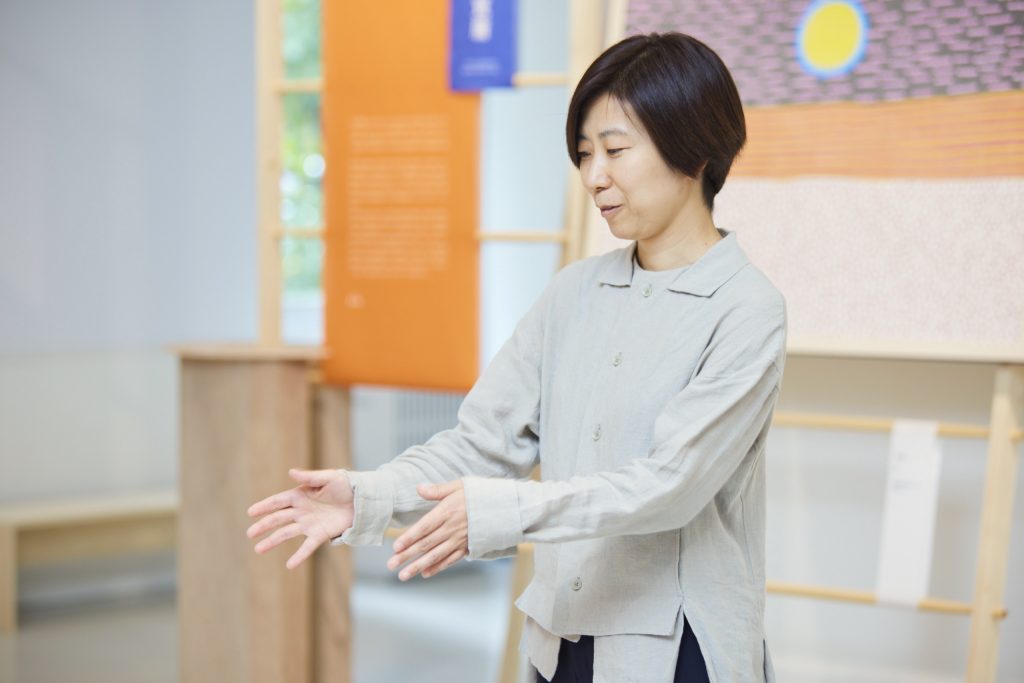
“What I really wanted you to see directly,” guided by the curator Ouchi, is the work of Hironobu Matsumoto.
Hironobu Matsumoto translates knowledge acquired from encyclopedias and books into abstract color schemes in two-dimensional images. The Battle Between the Positions of Kato Kiyomasa and Tokugawa Ieyasu is a grand piece depicting a fictional battle between Kiyomasa, the hero of Kumamoto, Mr. Matsumoto’s hometown, and Ieyasu of the Tokugawa shogunate. Mr. Matsumoto spent about two years creating this epic artwork. In recent years, he has expanded his themes from history to concepts like space and time, using the colors that appear in chemical reactions as motifs to express the Big Bang and the flow of time from past, present, to future.
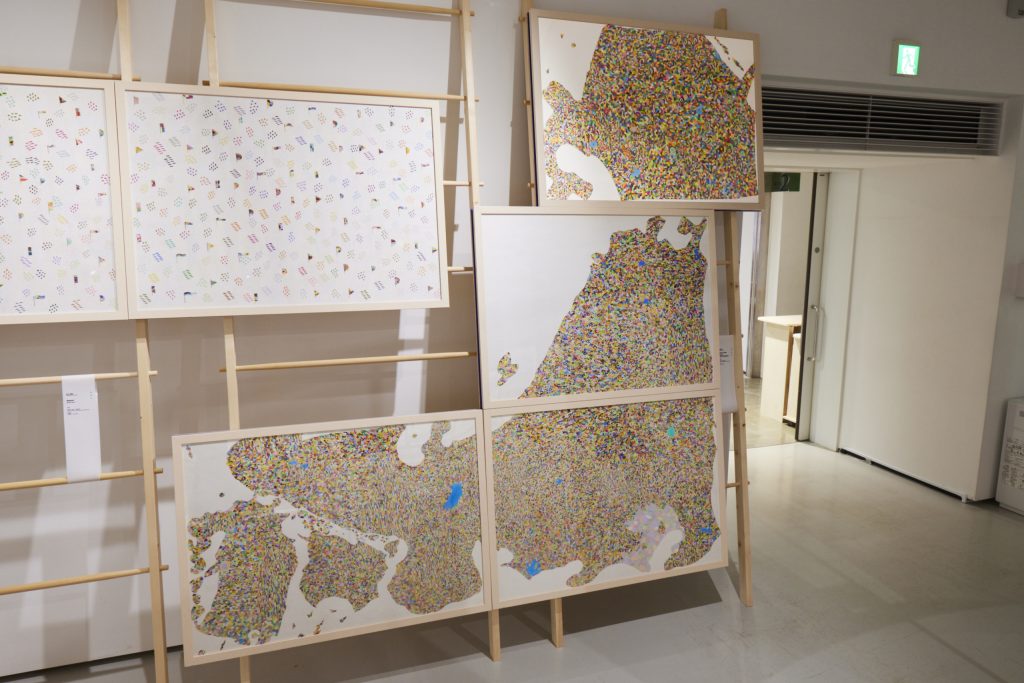
"This is incredible! Instead of painting the colors after completing the entire piece, he builds the image while applying the colors. The colors may represent both individuals and, at the same time, the flags of the armies?"
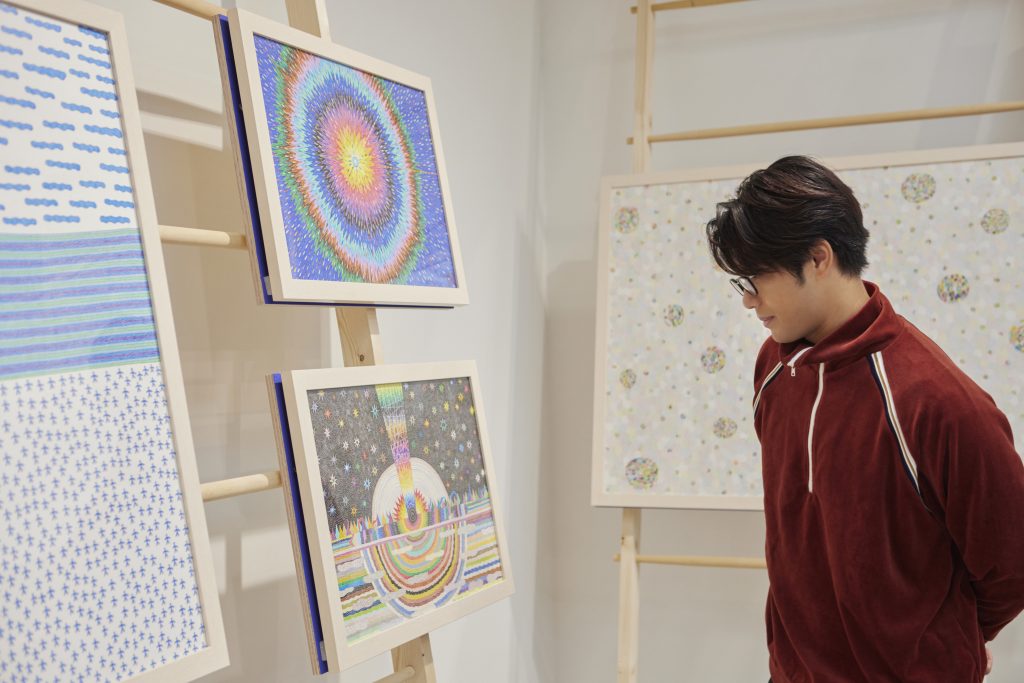
Next comes the meticulous and colorful formations drawn on graph paper, resembling blueprints yet appearing as decorative paintings with a sense of rhythm, created by Kenichi Yamazaki.
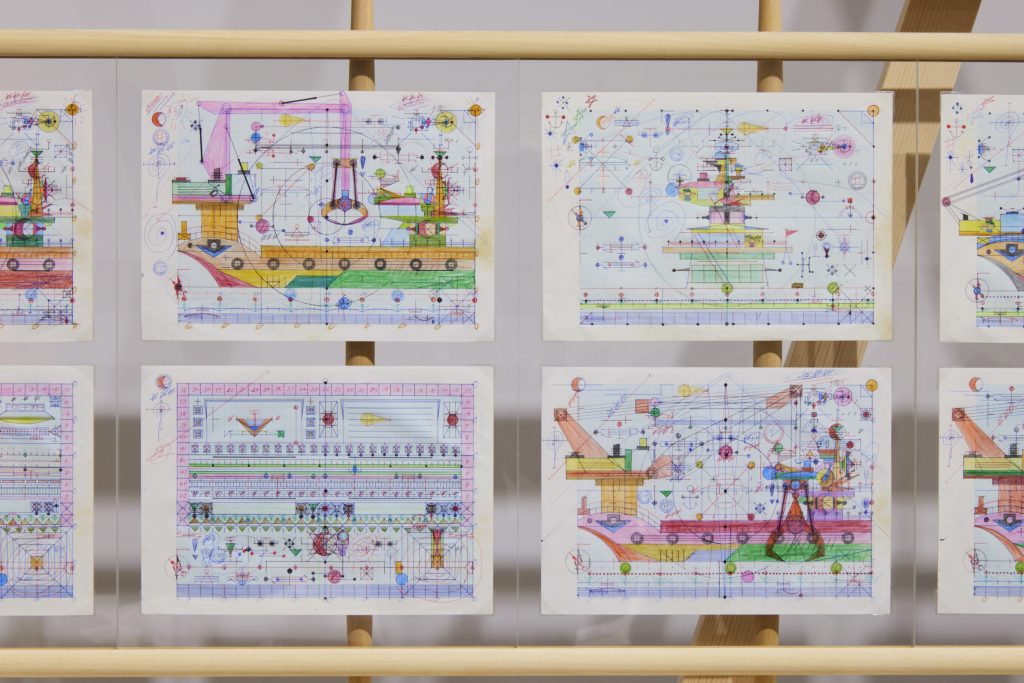
Kenichi Yamazaki, from Niigata, worked as a seasonal laborer on construction sites during the period of high economic growth. In his 30s, he fell ill and returned to his hometown from Tokyo. Until his passing in 2015, he continued to draw on graph paper in the hospital room where he was admitted. Memories of his own work experiences and recollections of his hometown are expressed geometrically, using compasses and rulers, with playful touches such as placing learning stickers here and there.
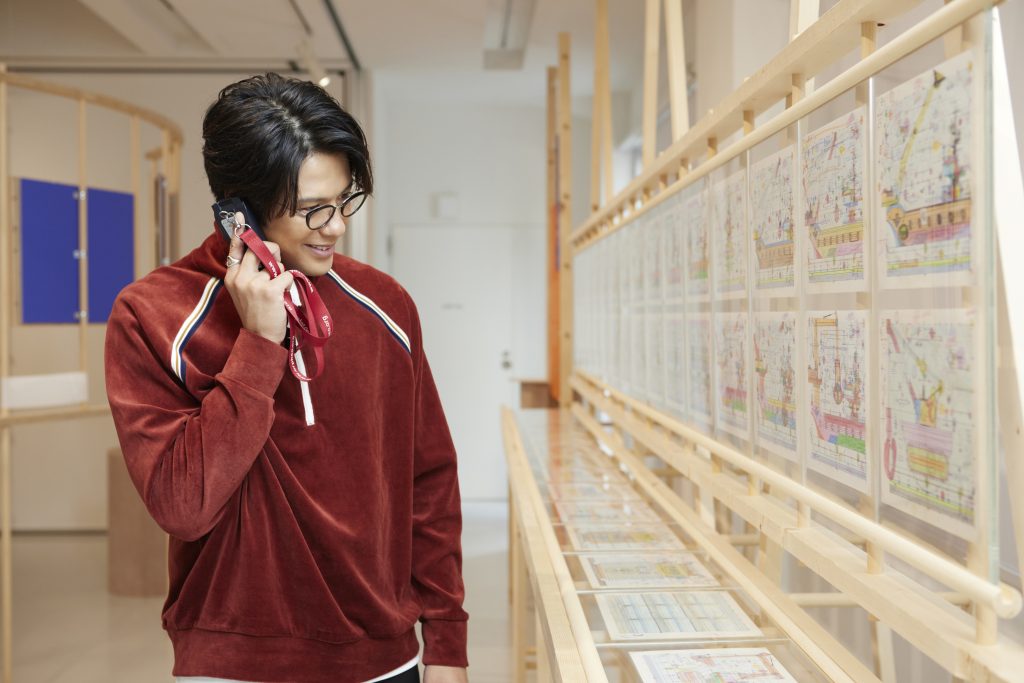
Finally, we enter the space surrounded by brilliantly colored birds, MIRUKA’s corner.
MIRUKA creates a unique world by depicting birds in rich colors and contrasting them with a background adorned with delicate-colored musical notes. Leveraging her background in drawing animated characters, she brings forth a new form of expression in this genre, incorporating a sense of flatness and pop art.
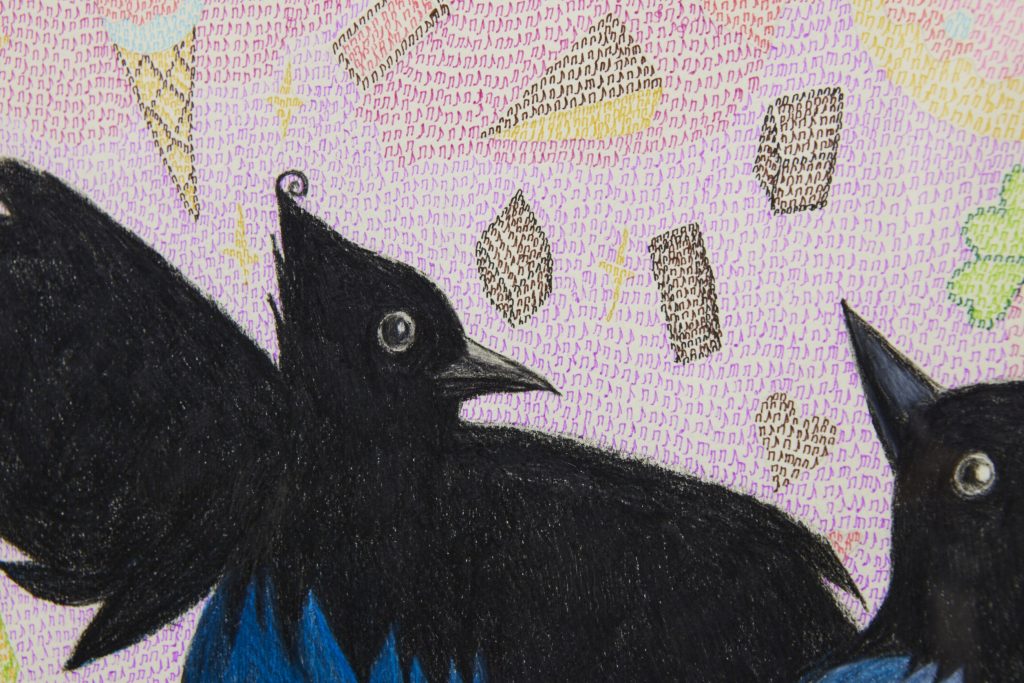
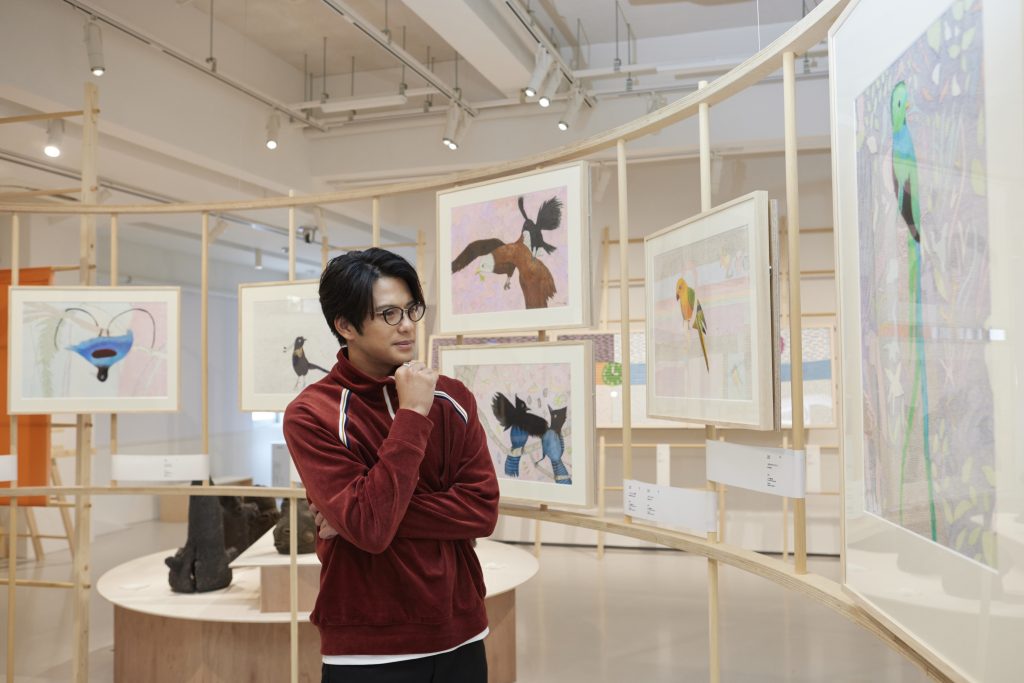
Mr. Morisaki, while carefully examining each piece, immerses himself in the emotions evoked by the artworks, the process of creation, and the intentions and feelings embedded by the artists. At times, he reveals his face as an artist, exuding excitement akin to that of a child.
As an artist, I gained the courage to be more liberated
How did you feel when you were offered to be the audio guide for this exhibition this time?
Morisaki: It doesn’t happen frequently, but sometimes when I go to museums, I’ve found that having an audio guide enhances my enjoyment by providing insights that I wouldn’t have known otherwise. I always thought it was a good addition. I’ve been particularly interested in it as a form of expression different from voice actors or narration. So, when I was approached to do it for the first time this time, I was happy and felt like saying, “Sure, I’ll do it!” (laughs).
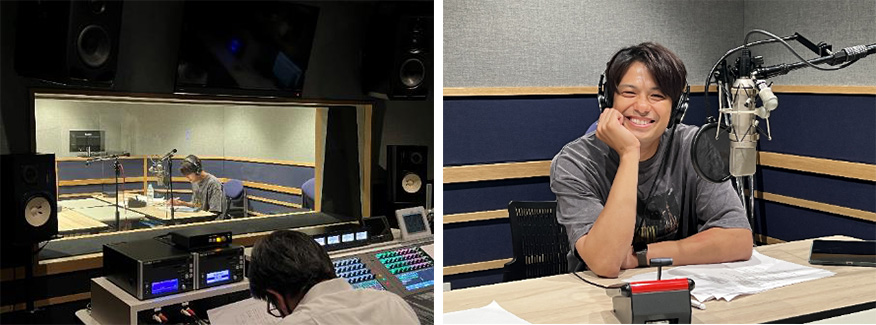
Were there any challenges or considerations you faced in the narration and expression for the guide?
Morisaki: Narration has various expressive methods, but this time, I tried to approach it naturally without overly acting. I particularly thought that the prologue and epilogue could have a touch of my own style.
How did you feel listening to your own audio guide today?
Morisaki: It’s really good. (laughs)
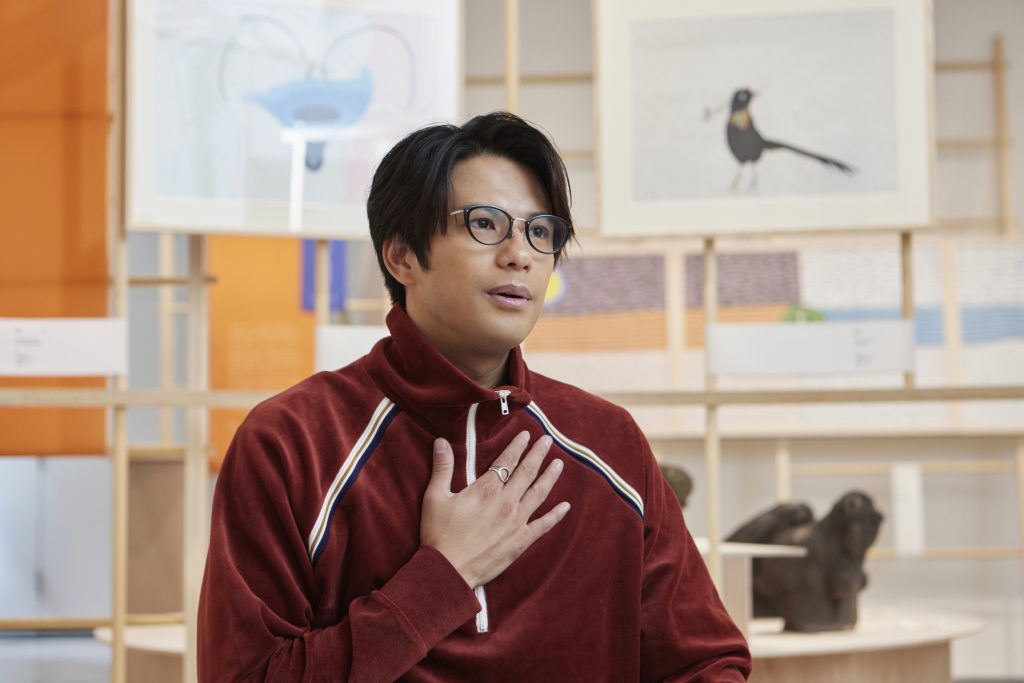
Were you familiar with the term and meaning of Art Brut?
Morisaki: Now that the recording of the audio guide is complete and I’m looking at the artworks, it feels like I’ve known them forever (laughs). It doesn’t feel like the first time I’ve heard the term, but it was the first time I learned about it when I received this offer.
What are your thoughts on the concept and the artworks associated with it?
Morisaki: When I read the narration and viewed the artworks today, what struck me most was the pure realization that both creators and audience are free, and that’s wonderful. While education and systems are undoubtedly important elements, I once again felt that it’s not necessary to be bound by them. (Forgive me for being presumptuous) As an artist (or a creative individual) myself, it reiterated that not having specialized education in the field doesn’t mean there are things I shouldn’t or couldn’t do.
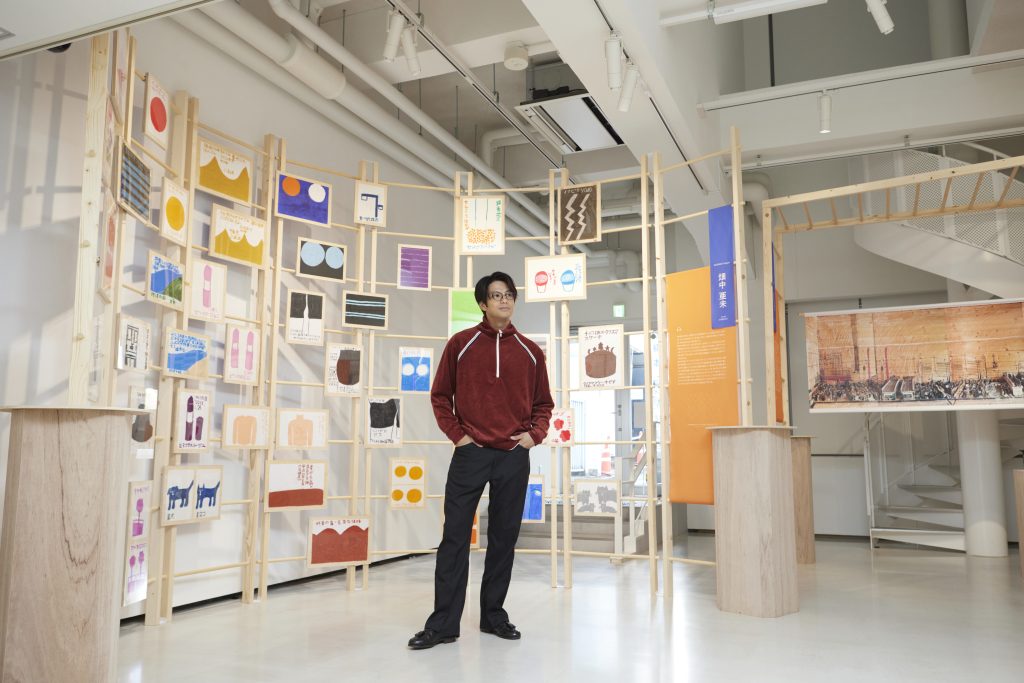
Did you have a favorite artwork after viewing the exhibition?
Morisaki: I’d love to have MIRUKA’s Resplendent Quetzal. It’s a bit large, but I’d like to display it at home. Also, Takeshi Tominaga’s Takoyaki Taro, an automaton doll eating takoyaki made from beer cans. Creating such a piece from empty cans is truly impressive.
Art, I think, is highly subjective to individual preferences. Personally, I find painting a bit challenging. With landscape paintings, the more I understand their history and context, the more appreciable they become. Since I have a hobby of taking photos, I can sometimes feel, “Ah, this composition works well.” However, things that are even more “artistic” can be truly challenging. I might feel like I could draw them myself, but in reality, I can’t. There’s something different about it. Still, it’s fascinating and enjoyable to be exposed to things you don’t fully comprehend. It means that the viewer is free to look, right? The same applies to music. Even in conversations like this, what resonates or is imagined can vary from person to person. Watching with someone else could be beneficial, as it expands the perspectives based on each person’ experiences and memories.
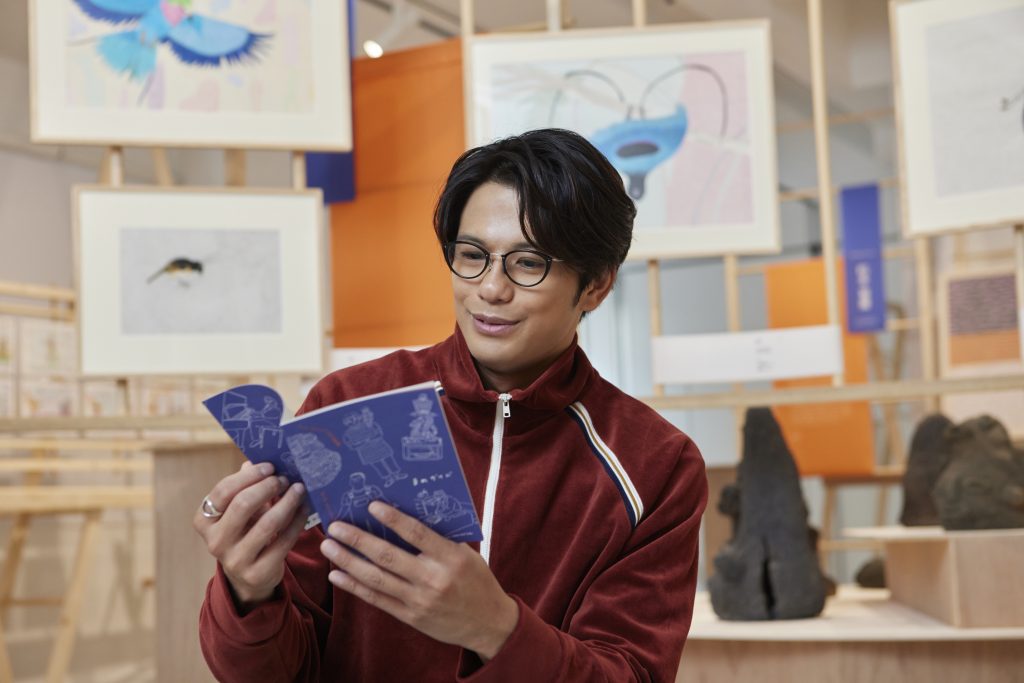
Through this experience, do you think there will be any influences on your future artistic activities, Mr. Morisaki?
Morisaki: Influences from experiences aren’t immediately apparent, especially if they aren’t significantly profound. They often manifest in expressions without conscious awareness. This time, not just with the narration but being here, it’s been really good. The emotions that surfaced while viewing the artworks today don’t have to be immediately processed within me. Yet, I believe they will be somehow incorporated over time. Having such thoughts recently, I’ve been thinking if this is what it means to become an adult (laughs).
When I go to an art museum, I find myself unable to leave the place. I get absorbed into it. Last year, I went to see the exhibition “Finn Juhl and Danish Chairs” at the Tokyo Metropolitan Art Museum in Ueno. While I was there, I became curious about “how they are made” and got so engrossed... Finally, I reached a resting area where you could sit on chairs designed by him. When I sat down, I felt a sense of joy. I even started thinking about buying one and redesigning my room (laughs).
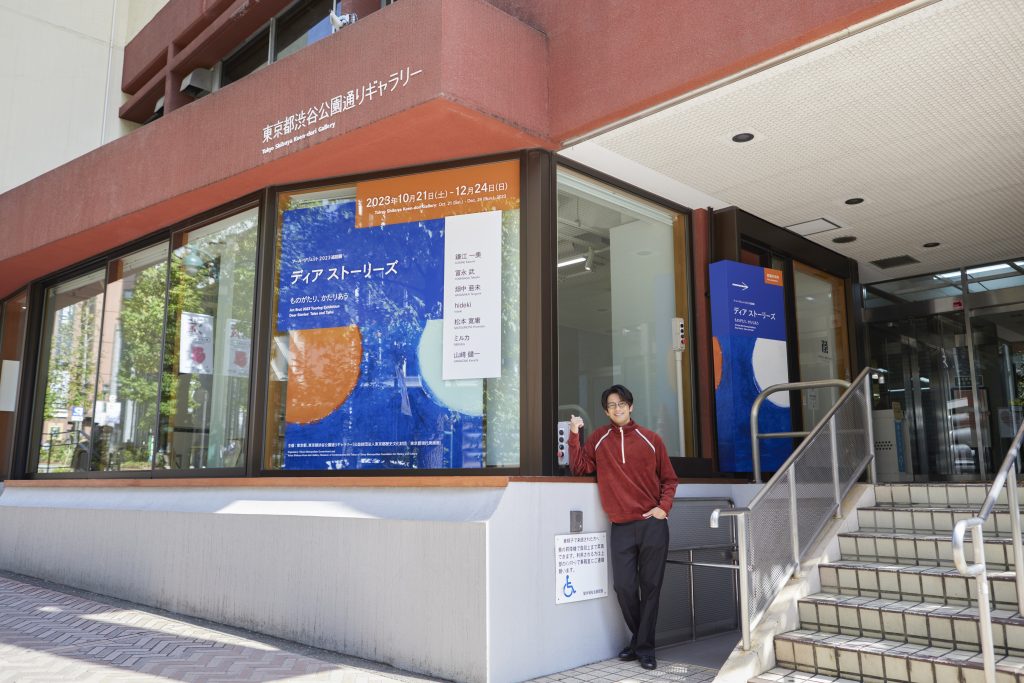
With a consciousness and pride as an artist, Win Morisaki engages with artworks through a genuine sensibility. If you explore the venue with a relaxed and free approach, as he suggests, the experience is likely to resonate unexpectedly with your lifestyle and mindset.
Japanese original text: Yuko Sakamoto
Photo: Tatsuro Kakishima
Translation: Kae Shigeno
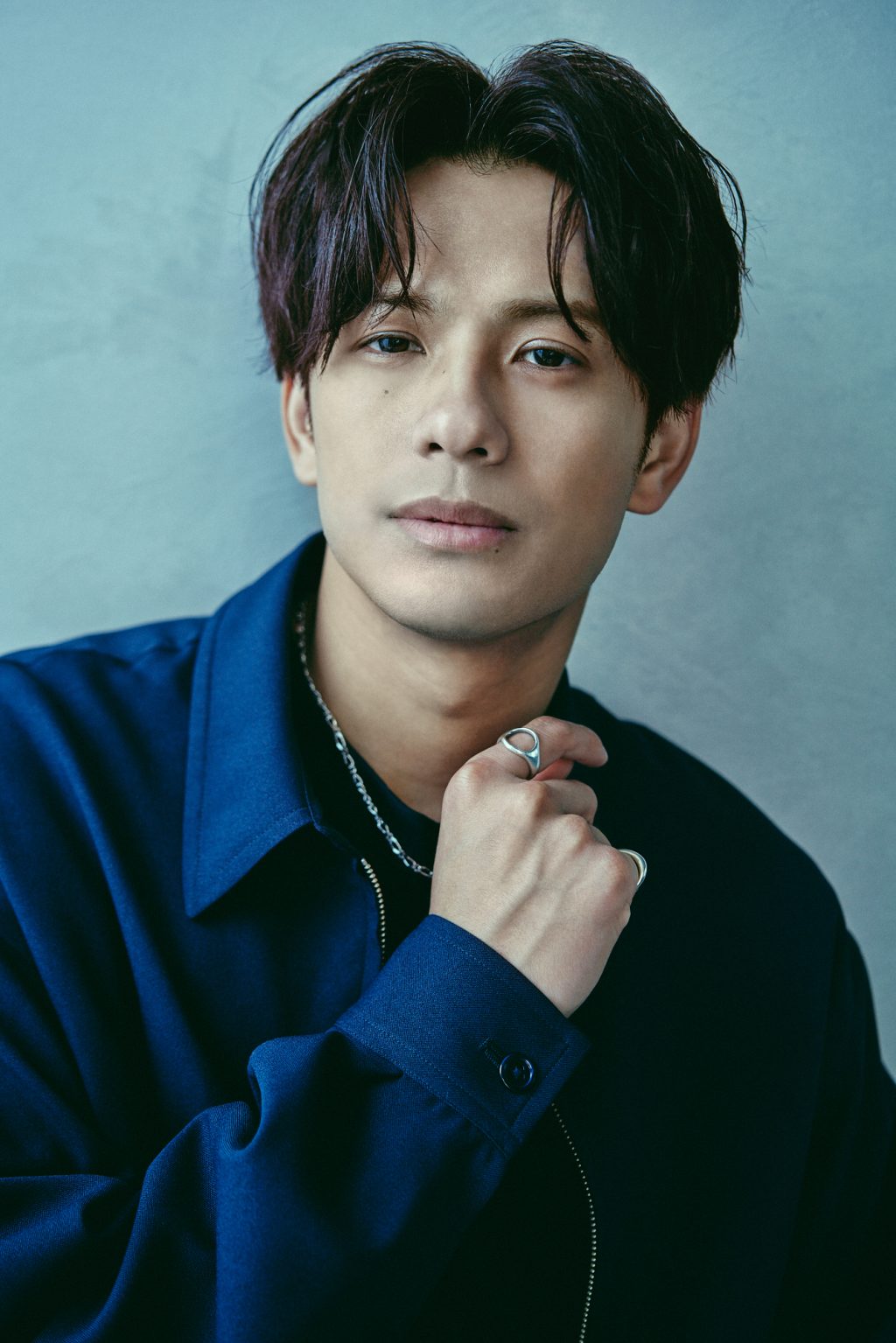
Win Morisaki (Actor/Artist)
Born in 1990 in Myanmar
Morisaki made his Hollywood debut by being selected for a major role in Director Steven Spielberg’s film Ready Player One, released in 2018. He won Newcomer of the Year in the 43rd Japan Academy Film Prize for his performance in the film Listen to the Universe (2020). Expanding the scope of his activities, he took on lead roles in musicals such as West Side Story and the popular Japanese manga SPY×FAMILY. In the 2023 NHK taiga year-long historical drama serial Dosuru Ieyasu (What to Do? Ieyasu), Morisaki portrays Tokugawa Hidetada, the second Tokugawa shogun.
Morisaki is also active as a musician. His major debut as MORISAKI WIN with the song Parade - PARADE (2020) was featured in a commercial and topped music streaming charts. In the tokusatsu superhero series Avataro Sentai Donbrothers, he contributed as the performer of the theme song and ending song, gaining popularity across a wide age range.
Since 2018, he has served as a tourism ambassador for his native country, Myanmar, where he has appeared in numerous dramas and commercials, boasting overwhelming recognition.
Art Brut 2023 Touring Exhibition
Dear Stories: Tales and Talks
Exhibition Period: October 21 (Sat.)-December 24 (Sun.), 2023
Hours: 11:00 a.m.-7:00 p.m.
Closed: Mondays.
Venue: Tokyo Shibuya Koen-dori Gallery, Gallery 1 & 2
Admission: Free
Organizers: Tokyo Metropolitan Government, Tokyo Shibuya Koen-dori Gallery, Museum of Contemporary Art Tokyo of Tokyo Metropolitan Foundation for History and Culture
Cooperated by: Tachikawa City, Hamura City Board of Education
Supported by: Sumida City
https://inclusion-art.jp/en/archive/exhibition/2023/20231021-225.html
※ This exhibition will tour to TAMASHIN RISURU Hall (Tachikawa City Civic Center) Exhibition Room from January 24 (Wed.)-February 7 (Wed.), 2024.


